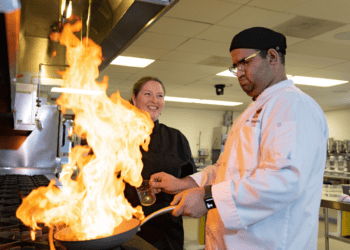Energizing the Economy after COVID: Orange County’s Energy, Construction and Utilities Sector with Regional Director Jon Caffery Feature Story
June 30, 2020

From the buildings we live and work in to getting a glass of water from the tap, the Energy, Construction, and Utilities (ECU) sector forms the foundation for almost all modern living. In Orange County, this sector employs 145,485 people (nearly 12 percent of the state’s overall ECU employment) at average earnings of $86,964 a year according to a report by the Orange County Center of Excellence. At the same time, industries are growing steadily at six percent, creating over nine thousand new jobs during the next five years.
The impact of COVID-19 on the sector has only increased demand.
“ECU was lucky enough to be deemed essential, so we’ve been less impacted than some of the other sectors,” says ECU Regional Director of Employer Engagement, Jon Caffery. “But even before the pandemic, ECU had a really drastic shortage of qualified workforce. So COVID just compounded this. The good news, employers are more eager than ever to find and hire qualified employees. All you need is the right education.”
Over the last couple months, ECU sector programs across the region have adopted online delivery formats to continue instruction—not an easy task given the hands-on nature of these classes.
“We were fortunate to team up with a company called Interplay who provided free access to their 3D, virtual reality training simulations for our faculty and students,” says Caffery.
While still being developed, instructors across the region are looking to the future and discussing innovative ways to provide the hands-on instruction students need. Some options being discussed include hybrid online/on-campus courses, staggered lab scheduling for students, as well as virtual reality training coupled with “validation days” in which students come in and get graded on their skills.
“There’s no question that faculty miss the live interaction with their students,” says Caffery. “But they’re also starting to see the benefit of using online platforms. Not only are online classes more flexible for students with busy schedules, students who have used a virtual reality component come in more prepared because they’ve already solved ‘real-world’ problems, even if just virtually. It helps cement learning and helps in-person labs move along quicker. It has also given us an opportunity for our online courses to have a lab aspect they’ve never had before.”
In addition to working with programs and industry to overcome the immediate obstacles presented by COVID-19, Caffery is continuing with his main task of working with regional businesses by developing innovative programs and partnerships across the region to make sure Orange County’s ECU sector has the well-educated workforce it needs to thrive.
“Energy efficiency — which is the foundation of the ECU sector — crosses all sectors,” says Caffery. “Sustainability and bottom-line efficiencies are all affected by how we use energy. On top of that, the careers are high-paying. They are lifelong jobs with multiple opportunities for advancement and crossover.”
Caffery’s lifelong passion for the ECU sector began in the Navy where he worked as an aviation electrician. He went on to start his own business as an electrical contractor for 10 years before moving on to construction contracting, mortgage banking, and becoming the Chairman for the Palm Springs Planning Commission. His business acumen led him to become a grant administrator at various universities, starting in 2010.
“They saw a businessman and an opportunity for me to come in and straighten things out, which I did,” says Caffery. Most recently, Caffery found his true passion when he became the Proposition 39 director and regional director for ECU at the Inland Empire/Desert Regional Consortium where he spent the past five years before coming to Orange County in February 2020.
Caffery is excited to support the region’s ECU programs and help launch more degree pathways to meet student and industry needs.
“It’s all about economic vitality,” he says. “If businesses can’t get the workforce that they need, they can’t expand.”
While in the Inland Empire, one of Caffery’s major successes was the development of the Building and Energy Systems Professional pathway, which is made up of stackable awards designed to streamline entry into the sector’s high-paying occupations.
“It provides off-ramps into careers and on-ramps back into education,” says Caffery, who has hopes to bring a similar program to Orange County. “As you are building your certificates and stacking them, you become more valuable to employers in the ECU sector.”
In addition to the development of broad initiatives, Caffery is also focused on expanding educational opportunities for high-demand and high-paying skilled trades, such as those found in carpentry. According to Caffery, carpenters can start at $18 an hour with full benefits and earn a $4 raise every six months as long as they are in an apprenticeship program and progressing.
“Carpenters are multifaceted,” says Caffery. “They are the first people on the job and the last people to leave.”
Part of this significant demand is because carpenters are essential to building bridge infrastructure. With Senate Bill 1, also known as the Road Repair and Accountability Act of 2017, set to invest $54 billion over the next decade to fix California’s roads and bridges, Caffery says “that’s enough to put everyone on alert for the next five years to start ramping up and hiring.”
Another area of focus for Caffery is automation, which is quickly becoming a core component of many buildings’ environmental, fire, and security controls.
According to Caffery, “Automation is everywhere, in every building and in every industry.”
Caffery has plans to help strengthen an emerging regional certificate on the fundamentals of automation, which covers robotics, programmable logic controllers, and building automation basics. While Fullerton College launched the certificate this fall, Caffery will help to drive the completion of the new certificate at other regional colleges.
“The more they [students] know about automation,” says Caffery, “the more opportunity they have to grow with their employers.”
Caffery also plans to focus on the creation employer bridge programs. Utilizing contract education, these programs engage with employers in order to offer supplementary, short-term training to students in their final semesters to help them make a smooth transition into the workforce.
One successful example of this kind of program is one Caffery developed with the California Construction and Industrial Materials Association (CalCIMA) while in the Inland Empire. Comprised of over 70 companies and over 250 production sites in every county in the state, the association is excited to continue to collaborate with community colleges to grow their talent pipeline.
“It’s the idea of our students having that specialized, quick opportunity for training that increases their chances of employment,” says Caffery.
The training would be specifically geared toward students who have a foundation in relevant competencies to give them an extra boost. Best of all, training could take as little as 48 hours and would also set them up with an interview to help them get their foot in the door for their first job. According to Caffery, “It’s a huge potential for growth.”
For other employer bridge programs, Caffery has an eye on construction and construction management companies where demand is high and jobs pay handsomely. Caffery also thinks automation is another field prime for a bridge program because of the many different competencies required and how it feeds into a variety of industries.
Moving forward, Caffery is committed to finding areas of need within the sector and filling educational and workforce gaps by making connections with industry and with colleges, getting students employed, and supporting the economic vitality of the region. Most of all, he’s looking forward to new programs that turn into new hires.
“People are looking for stability these days,” reflects Caffery. “And there really isn’t a better industry for that than ECU. We’re an essential service, which means we’re not going anywhere. Plus, the demand is huge and there are great salaries to be made. Given all the uncertainty these days, I’d say ECU is a good, if not a great, place to be.”
For more information about the many ECU sector programs offered by Orange County’s community college career education programs, visit www.FutureBUILT.org.




